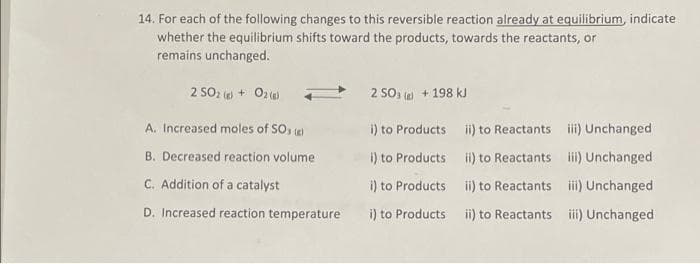14. For each of the following changes to this reversible reaction already at equilibrium, indicate whether the equilibrium shifts toward the products, towards the reactants, or remains unchanged. 2 SO2 + Oz 2 SO, e + 198 k. A. Increased moles of SO, e i) to Products ii) to Reactants iii) Unchanged B. Decreased reaction volume i) to Products ii) to Reactants ii) Unchanged C. Addition of a catalyst i) to Products ii) to Reactants iii) Unchanged D. Increased reaction temperature i) to Products ii) to Reactants iii) Unchanged
14. For each of the following changes to this reversible reaction already at equilibrium, indicate whether the equilibrium shifts toward the products, towards the reactants, or remains unchanged. 2 SO2 + Oz 2 SO, e + 198 k. A. Increased moles of SO, e i) to Products ii) to Reactants iii) Unchanged B. Decreased reaction volume i) to Products ii) to Reactants ii) Unchanged C. Addition of a catalyst i) to Products ii) to Reactants iii) Unchanged D. Increased reaction temperature i) to Products ii) to Reactants iii) Unchanged
Chemistry & Chemical Reactivity
9th Edition
ISBN:9781133949640
Author:John C. Kotz, Paul M. Treichel, John Townsend, David Treichel
Publisher:John C. Kotz, Paul M. Treichel, John Townsend, David Treichel
Chapter15: Principles Of Chemical Reactivity: Equilibria
Section15.2: The Equilibrium Constant And Reaction Quotient
Problem 2CYU: Answer the following questions regarding the butane isobutane equilibrium (Kc = 2.50 at 298 K). (a)...
Related questions
Question
Please answer all the parts

Transcribed Image Text:14. For each of the following changes to this reversible reaction already at equilibrium, indicate
whether the equilibrium shifts toward the products, towards the reactants, or
remains unchanged.
2 SO2 + Oz
2 SO, + 198 kJ
A. Increased moles of SO, e)
i) to Products ii) to Reactants
iii) Unchanged
B. Decreased reaction volume
i) to Products i) to Reactants i) Unchanged
C. Addition of a catalyst
i) to Products ii) to Reactants iii) Unchanged
D. Increased reaction temperature
i) to Products ii) to Reactants ii) Unchanged
Expert Solution
This question has been solved!
Explore an expertly crafted, step-by-step solution for a thorough understanding of key concepts.
This is a popular solution!
Trending now
This is a popular solution!
Step by step
Solved in 2 steps with 1 images

Knowledge Booster
Learn more about
Need a deep-dive on the concept behind this application? Look no further. Learn more about this topic, chemistry and related others by exploring similar questions and additional content below.Recommended textbooks for you

Chemistry & Chemical Reactivity
Chemistry
ISBN:
9781133949640
Author:
John C. Kotz, Paul M. Treichel, John Townsend, David Treichel
Publisher:
Cengage Learning

Chemistry & Chemical Reactivity
Chemistry
ISBN:
9781337399074
Author:
John C. Kotz, Paul M. Treichel, John Townsend, David Treichel
Publisher:
Cengage Learning

Chemistry
Chemistry
ISBN:
9781305957404
Author:
Steven S. Zumdahl, Susan A. Zumdahl, Donald J. DeCoste
Publisher:
Cengage Learning

Chemistry & Chemical Reactivity
Chemistry
ISBN:
9781133949640
Author:
John C. Kotz, Paul M. Treichel, John Townsend, David Treichel
Publisher:
Cengage Learning

Chemistry & Chemical Reactivity
Chemistry
ISBN:
9781337399074
Author:
John C. Kotz, Paul M. Treichel, John Townsend, David Treichel
Publisher:
Cengage Learning

Chemistry
Chemistry
ISBN:
9781305957404
Author:
Steven S. Zumdahl, Susan A. Zumdahl, Donald J. DeCoste
Publisher:
Cengage Learning


Chemistry: An Atoms First Approach
Chemistry
ISBN:
9781305079243
Author:
Steven S. Zumdahl, Susan A. Zumdahl
Publisher:
Cengage Learning

Introductory Chemistry: A Foundation
Chemistry
ISBN:
9781337399425
Author:
Steven S. Zumdahl, Donald J. DeCoste
Publisher:
Cengage Learning